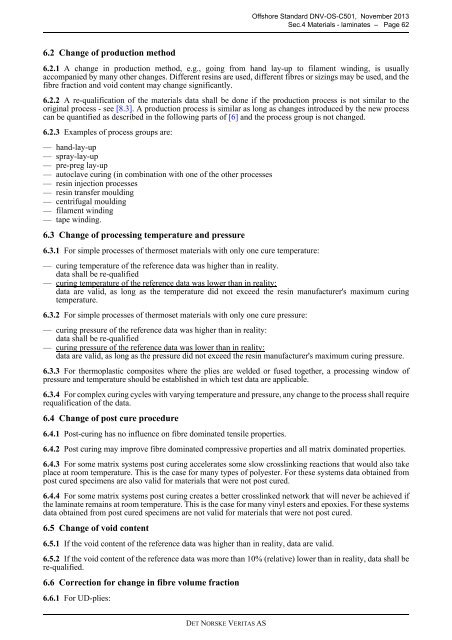OS-C501
Create successful ePaper yourself
Turn your PDF publications into a flip-book with our unique Google optimized e-Paper software.
Offshore Standard DNV-<strong>OS</strong>-<strong>C501</strong>, November 2013<br />
Sec.4 Materials - laminates – Page 62<br />
6.2 Change of production method<br />
6.2.1 A change in production method, e.g., going from hand lay-up to filament winding, is usually<br />
accompanied by many other changes. Different resins are used, different fibres or sizings may be used, and the<br />
fibre fraction and void content may change significantly.<br />
6.2.2 A re-qualification of the materials data shall be done if the production process is not similar to the<br />
original process - see [8.3]. A production process is similar as long as changes introduced by the new process<br />
can be quantified as described in the following parts of [6] and the process group is not changed.<br />
6.2.3 Examples of process groups are:<br />
— hand-lay-up<br />
— spray-lay-up<br />
— pre-preg lay-up<br />
— autoclave curing (in combination with one of the other processes<br />
— resin injection processes<br />
— resin transfer moulding<br />
— centrifugal moulding<br />
— filament winding<br />
— tape winding.<br />
6.3 Change of processing temperature and pressure<br />
6.3.1 For simple processes of thermoset materials with only one cure temperature:<br />
— curing temperature of the reference data was higher than in reality.<br />
data shall be re-qualified<br />
— curing temperature of the reference data was lower than in reality:<br />
data are valid, as long as the temperature did not exceed the resin manufacturer's maximum curing<br />
temperature.<br />
6.3.2 For simple processes of thermoset materials with only one cure pressure:<br />
— curing pressure of the reference data was higher than in reality:<br />
data shall be re-qualified<br />
— curing pressure of the reference data was lower than in reality:<br />
data are valid, as long as the pressure did not exceed the resin manufacturer's maximum curing pressure.<br />
6.3.3 For thermoplastic composites where the plies are welded or fused together, a processing window of<br />
pressure and temperature should be established in which test data are applicable.<br />
6.3.4 For complex curing cycles with varying temperature and pressure, any change to the process shall require<br />
requalification of the data.<br />
6.4 Change of post cure procedure<br />
6.4.1 Post-curing has no influence on fibre dominated tensile properties.<br />
6.4.2 Post curing may improve fibre dominated compressive properties and all matrix dominated properties.<br />
6.4.3 For some matrix systems post curing accelerates some slow crosslinking reactions that would also take<br />
place at room temperature. This is the case for many types of polyester. For these systems data obtained from<br />
post cured specimens are also valid for materials that were not post cured.<br />
6.4.4 For some matrix systems post curing creates a better crosslinked network that will never be achieved if<br />
the laminate remains at room temperature. This is the case for many vinyl esters and epoxies. For these systems<br />
data obtained from post cured specimens are not valid for materials that were not post cured.<br />
6.5 Change of void content<br />
6.5.1 If the void content of the reference data was higher than in reality, data are valid.<br />
6.5.2 If the void content of the reference data was more than 10% (relative) lower than in reality, data shall be<br />
re-qualified.<br />
6.6 Correction for change in fibre volume fraction<br />
6.6.1 For UD-plies:<br />
DET NORSKE VERITAS AS



